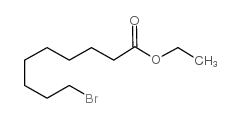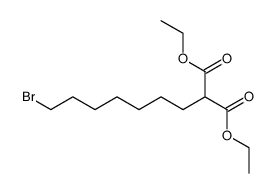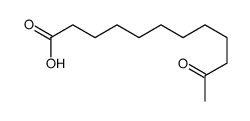28598-81-4
| Name | Ethyl 9-bromononanoate |
|---|---|
| Synonyms |
9-Brom-nonansaeure-aethylester
(8-carboxyethyl)octyl bromide Ethyl 9-BroMononanoate 9-bromo-nonanoic acid ethyl ester |
| Density | 1.17 |
|---|---|
| Boiling Point | 180ºC / 30mmHg |
| Molecular Formula | C11H21BrO2 |
| Molecular Weight | 265.18700 |
| Flash Point | 149.5ºC |
| Exact Mass | 264.07200 |
| PSA | 26.30000 |
| LogP | 3.67510 |
| Vapour Pressure | 0.00287mmHg at 25°C |
| Index of Refraction | 1.463 |
|
Ethyl 9-Bromononanoate
Revision number: 1
SAFETY DATA SHEET Section1. BASE INFORMATION Product name:Ethyl 9-Bromononanoate Revision number:1 Section2. HAZARDS IDENTIFICATION Classification of the GHS PHYSICAL HAZARDSNot classified HEALTH HAZARDS Category 2 Skin corrosion/irritation Serious eye damage/eye irritationCategory 2A Not classified ENVIRONMENTAL HAZARDS GHS label elements Pictograms or hazard symbols Signal wordWarning Hazard statementCauses skin irritation Causes serious eye irritation Precautionary statements [Prevention]Wash hands thoroughly after handling. Wear protective gloves/eye protection/face protection. [Response]IF IN EYES: Rinse cautiously with water for several minutes. Remove contact lenses, if present and easy to do. Continue rinsing. If eye irritation persists: Get medical advice/attention. IF ON SKIN: Gently wash with plenty of soap and water. If skin irritation occurs: Get medical advice/attention. Take off contaminated clothing and wash before reuse. Section3. COMPOSITION/INFORMATION ON INGREDIENTS Substance/mixture:Substance Component(s):Ethyl 9-Bromononanoate Percent:>95.0%(GC) CAS Number:28598-81-4 Synonyms:9-Bromononanoic Acid Ethyl Ester Chemical Formula:C11H21BrO2 Section4. FIRST AID MEASURES Inhalation:Remove victim to fresh air and keep at rest in a position comfortable for breathing. Get medical advice/attention if you feel unwell. Ethyl 9-Bromononanoate Section4. FIRST AID MEASURES Skin contact:Remove/Take off immediately all contaminated clothing. Gently wash with plenty of soap and water. If skin irritation or rash occurs: Get medical advice/attention. Eye contact:Rinse cautiously with water for several minutes. Remove contact lenses, if present and easy to do. Continue rinsing. If eye irritation persists: Get medical advice/attention. Ingestion:Get medical advice/attention if you feel unwell. Rinse mouth. A rescuer should wear personal protective equipment, such as rubber gloves and air- Protection of first-aiders: tight goggles. Section5. FIRE-FIGHTING MEASURES Suitable extinguishingDry chemical, foam, water spray, carbon dioxide. media: Extinguishing media not to Solid streams of water be used: Specific hazards:Take care as it may decompose upon combustion or in high temperatures to generate poisonous fume. Specific methods:Fire-extinguishing work is done from the windward and the suitable fire-extinguishing method according to the surrounding situation is used. Uninvolved persons should evacuate to a safe place. In case of fire in the surroundings: Remove movable containers if safe to do so. Special protectiveWhen extinguishing fire, be sure to wear personal protective equipment. equipment for firefighters: Section6. ACCIDENTAL RELEASE MEASURES Personal precautions,Use personal protective equipment. Keep people away from and upwind of spill/leak. protective equipment and Ensure adequate ventilation. Entry to non-involved personnel should be controlled emergency procedures: around the leakage area by roping off, etc. Environmental precautions: Prevent product from entering drains. Methods and materials for Absorb spilled material in a suitable absorbent (e.g. rag, dry sand, earth, saw-dust). containment and cleaning In case of large amount of spillage, contain a spill by bunding. Adhered or collected up: material should be promptly disposed of, in accordance with appropriate laws and regulations. Section7. HANDLING AND STORAGE Handling Technical measures:Handling is performed in a well ventilated place. Wear suitable protective equipment. Prevent generation of vapor or mist. Wash hands and face thoroughly after handling. Use a ventilation, local exhaust if vapor or aerosol will be generated. Advice on safe handling:Avoid contact with skin, eyes and clothing. Storage Storage conditions:Keep container tightly closed. Store in a cool and dark place. Store away from incompatible materials such as oxidizing agents. Packaging material:Law is followed. Section8. EXPOSURE CONTROLS / PERSONAL PROTECTION Engineering controls:Install a closed system or local exhaust as possible so that workers should not be exposed directly. Also install safety shower and eye bath. Personal protective equipment Respiratory protection: Vapor respirator. Follow local and national regulations. Hand protection:Protective gloves. Eye protection:Safety glasses. A face-shield, if the situation requires. Skin and body protection: Protective clothing. Protective boots, if the situation requires. Section9. PHYSICAL AND CHEMICAL PROPERTIES Liquid Physical state (20°C): Form:clear Ethyl 9-Bromononanoate Section9. PHYSICAL AND CHEMICAL PROPERTIES Color:Colorless - Pale yellow Odor:No data available pH: No data available Melting point/freezing point:No data available Boiling Point/Range:180 °C/4kPa Flash Point:No data available Explosive limits No data available Lower: Upper:No data available 1.17 Density: Solubility:No data available Section10. STABILITY AND REACTIVITY Stability:Stable under proper conditions. Reactivity:No special reactivity has been reported. Incompartible materials: oxidizing agents Hazardous Decomposition Carbon monoxide, Carbon dioxide, Hydrogen bromide Products: Section11. TOXICOLOGICAL INFORMATION No data available Acute Toxicity: Skin corrosion/irritation: No data available Serious eyeNo data available damage/irritation: Germ cell mutagenicity: No data available Carcinogenicity: No data available IARC = NTP =No data available No data available Reproductive toxicity: Section12. ECOLOGICAL INFORMATION Ecotoxicity: Fish:No data available Crustacea:No data available Algae:No data available Persistence / degradability: No data available BioaccumulativeNo data available potential(BCF): Mobillity in soil log Pow:No data available Soil adsorption (Koc):No data available Henry's LawNo data available constant(PaM3/mol): Section13. DISPOSAL CONSIDERATIONS Recycle to process, if possible. Consult your local regional authorities. You may be able to burn in a chemical incinerator equipped with an afterburner and scrubber system. Observe all federal, state and local regulations when disposing of the substance. Section14. TRANSPORT INFORMATION Hazards Class:Does not correspond to the classification standard of the United Nations UN-No:Not Listed Ethyl 9-Bromononanoate Section15. REGULATORY INFORMATION Safe management ordinance of dangerous chemical product (State Council announces on January 26, 2002): Safe use and production, the storage of a dangerous chemical, transport, loading and unloading were prescribed. SECTION 16 - ADDITIONAL INFORMATION N/A |
| HS Code | 2915900090 |
|---|
|
~% 
28598-81-4 |
| Literature: Salmon-Legagneur et al. Bulletin de la Societe Chimique de France, 1957 , p. 1463,1467 |
|
~% 
28598-81-4 |
| Literature: Salmon-Legagneur et al. Bulletin de la Societe Chimique de France, 1957 , p. 1463,1467 |
|
~% 
28598-81-4 |
| Literature: Kinoshita,M.; Umezawa,S. Bulletin of the Chemical Society of Japan, 1961 , vol. 34, p. 308 - 312 |
|
~% 
28598-81-4 |
| Literature: CELLTECH R and D LIMITED Patent: WO2005/117984 A2, 2005 ; Location in patent: Page/Page column 33-34 ; |
| Precursor 5 | |
|---|---|
| DownStream 5 | |
| HS Code | 2915900090 |
|---|---|
| Summary | 2915900090 other saturated acyclic monocarboxylic acids and their anhydrides, halides, peroxides and peroxyacids; their halogenated, sulphonated, nitrated or nitrosated derivatives VAT:17.0% Tax rebate rate:9.0% Supervision conditions:AB(certificate of inspection for goods inward,certificate of inspection for goods outward) MFN tariff:5.5% General tariff:30.0% |








